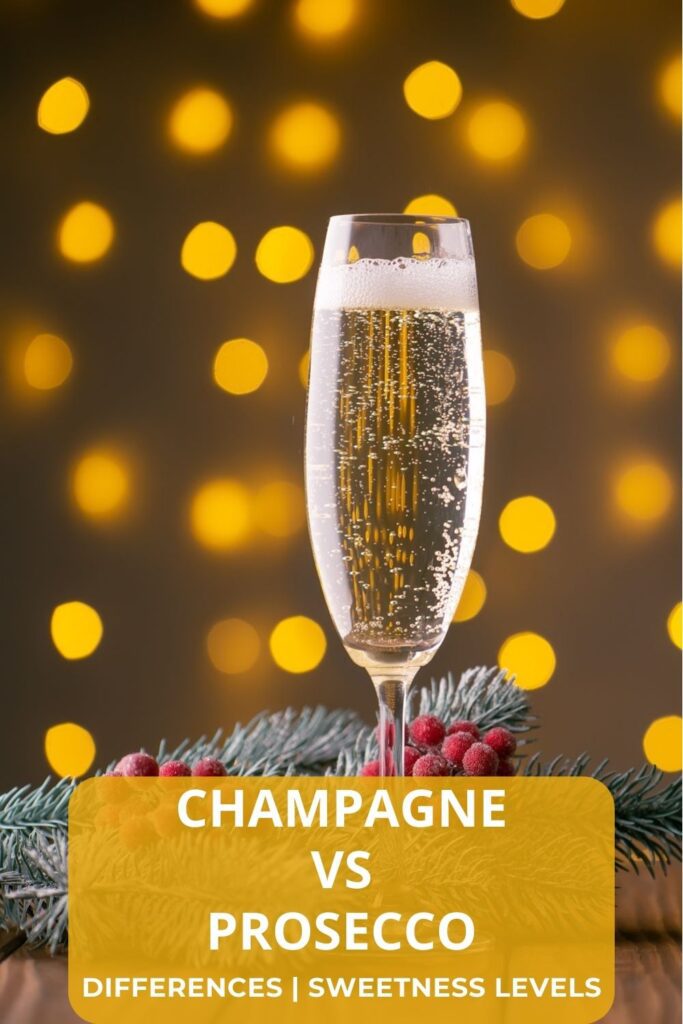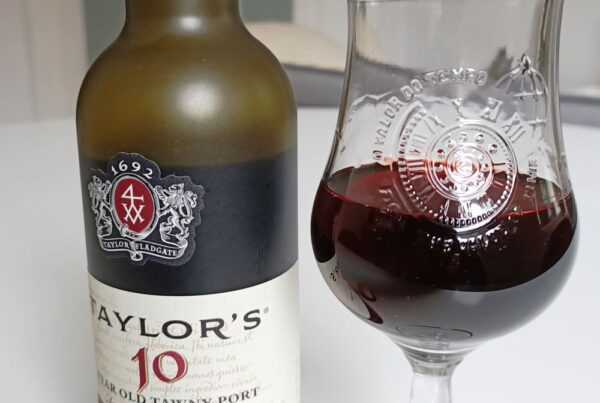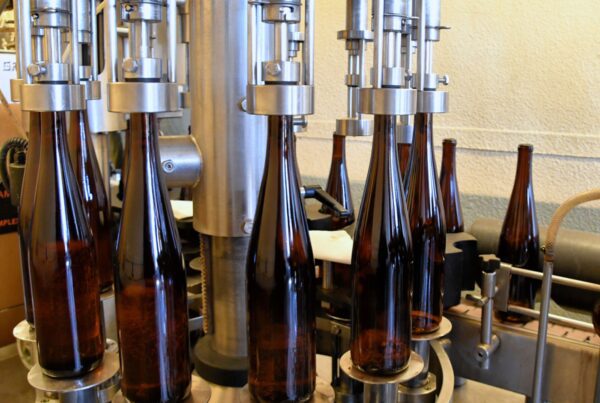This article compares Prosecco, Champagne and Cava.
Champagne is synonymous with luxury, celebration and achievement, but what about Prosecco and other sparkling wines – do they taste as good as Champagne, are they cheaper, are they made the same way or differently?
Contents
- 1 Prosecco Champagne and Cava comparison
- 2 Taste differences between Champagne, Prosecco and Cava
- 3 Sugar content in Champagne, Prosecco, Cava and other sparkling wines
- 4 Calories in sparkling wines
- 5 Prices of sparkling wines / cost of Champagne, Prosecco and Cava
- 6 Alcohol content of sparkling wines
- 7 Other sparkling wines
- 8 Sparkling wines and cocktails
- 9 Prosecco glass vs champagne glass
Prosecco Champagne and Cava comparison
At first glance, Prosecco, Champagne and Cava wine look very similar, but as you can see from the table below they are made with different grapes, using different methods and have different flavor profiles.
| Category | Prosecco | Champagne | Cava |
| Country of Origin | Italy (Primarily Veneto region) | France (Champagne region) | Spain (Primarily Catalonia) |
| Grapes | Glera (primarily) | Chardonnay, Pinot Noir, Pinot Meunier | Macabeo, Xarel·lo, Parellada |
| Method of Production | Charmat (Tank Method) | Traditional (Méthode Champenoise) | Traditional (Método Tradicional) |
| Flavor | Light, fruity, floral | Rich, complex, toasty, yeasty | Crisp, citrusy, sometimes earthy |
| Color | Pale straw-yellow | Light gold to deep amber | Pale yellow with greenish tones |
| Price | Typically affordable ($10–$25) | Higher-end ($40 and above) | Affordable to mid-range ($10–$30) |

Taste differences between Champagne, Prosecco and Cava
Sparkling wines may all look similar, but they are made in different styles, with different grapes, different blends and can be sweet or dry and everything in between.
They can taste fruity and fresh or toasty and biscuity.
The purpose of this article isn’t to go into great detail about the winemaking methods for each, but rather to discuss the similarities and differences to help you make a more informed decision on what sparkling wine to buy.
Champagne and Cava are both made using the traditional method, so Cava is more similar to Champagne than Prosecco.
Traditional method
The traditional method is both labor and cost intensive, and it is usually reserved for high-end sparkling wines.
The wine is in contact with the lees (yeast) for nine months during the second fermentation, so it tends to have more complex and autolytic flavors (toasty, biscuity) than Prosecco.
Champagne, generally, has more complexity than Cava.
All three sparkling wines begin in the same way – a still, dry wine is produced (first fermentation) but the second fermentation is different for Prosecco.
The second fermentation occurs when sugar and yeast are added to the still wine. The wine increases slightly in alcohol and the carbon dioxide, which cannot escape, becomes dissolved in the wine. This is what creates the bubbles.
Using the traditional method, this second fermentation occurs in the bottle.
Prosecco is made using the tank method where the dry base wine is put into a pressurised tank with sugar and yeast and the tank is sealed.
A second fermentation takes place, creating carbon dioxide gas (bubbles). The wine is filtered and bottled under pressure.
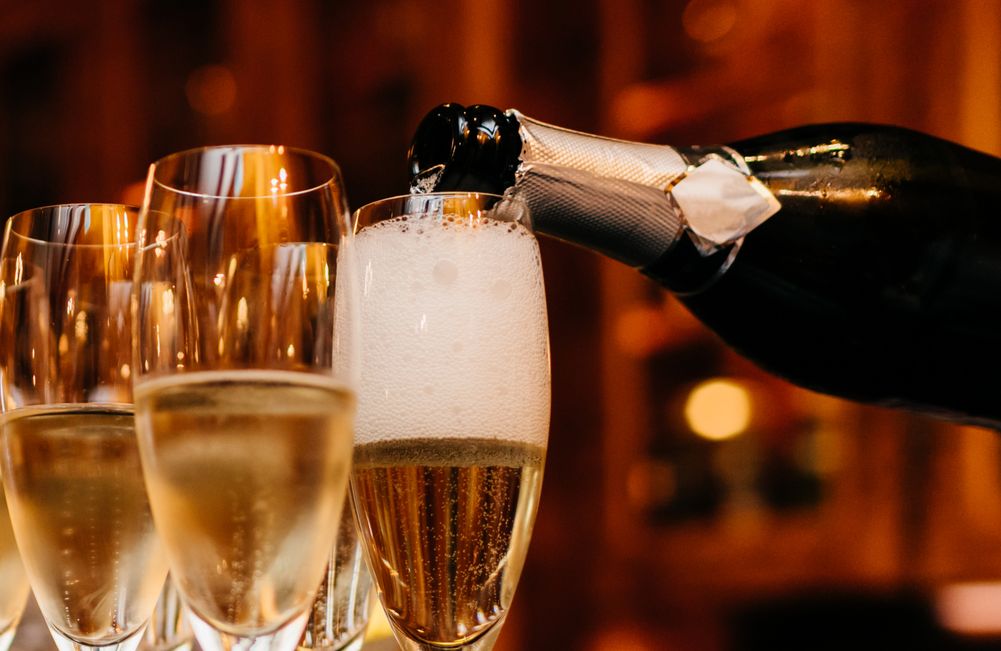
Sugar content in Champagne, Prosecco, Cava and other sparkling wines
Sparkling wines are made in a range of sweetness levels, so it isn’t the case that one type is sweeter or drier than the other.
Instead, it is a question of knowing sparkling wine labelling terms in order to purchase the desired sweetness level for whichever sparkling wine you choose.
The EU has labelling terms to denote sweetness levels that must be used for sparkling wines.
Many of these labelling terms are copied or are similar around the world. They are a good indication of sweetness levels, but the labelling terminology may differ depending on where you are.
It is worth noting that there is a range within each level, so producers may be on the lower or higher end of these ranges.
The terms ‘brut’ and ‘sec’ mean dry, but as you can see from the infographic below, even sparkling wines on the higher end of the sweetness scale can contain these terms.
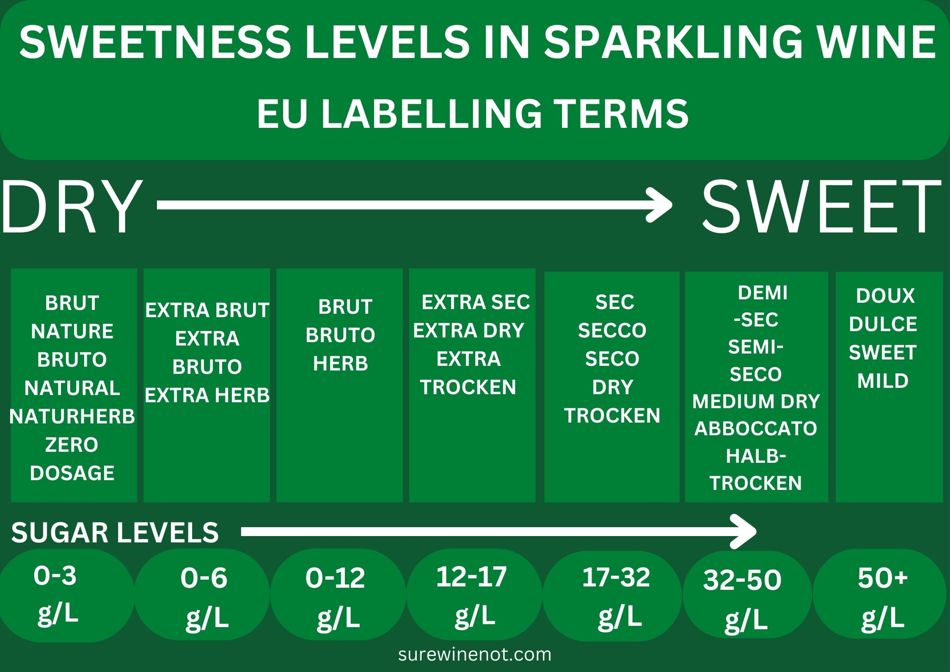
Calories in sparkling wines
Dry sparkling wines have less calories than sweeter sparkling wines. This is due to the residual sugar levels after fermentation – dry sparkling wines have lower sugar levels and therefore less calories.
It is not possible to give an exact calorie number because the sugar level in sparkling wines vary, even within levels of sweetness, as previously mentioned.
The number, of course, also depends on the size of your glass of sparking wine.
But let’s take a typical flute of sparkling wine of 5oz (142 ml). The driest sparkling wine will be about 95 calories, the sweetest approx. 120 calories (possibly higher if very high in sugar).
So, drinking the driest level of sparkling wine will mean less calories, but the difference, as you can see is not much.

Prices of sparkling wines / cost of Champagne, Prosecco and Cava
Champagne is more expensive than other sparkling wines. Only sparkling wines made in the Champagne region in France to strict standards can be labelled Champagne.
Famous Champagne brands, like Dom Perignon can cost thousands of dollars or euros per bottle.
Cava and Prosecco, in general, are both very affordable wines, but higher quality versions are also available at higher prices.
Alcohol content of sparkling wines
The amount of alcohol in a bottle of sparkling wine varies, but, in general, it is around 12%.
Most Cava, for example, is 11.5%, but some are 11% and some are 12%.
Compared with still wine, sparkling wine can be described as having medium alcohol levels.
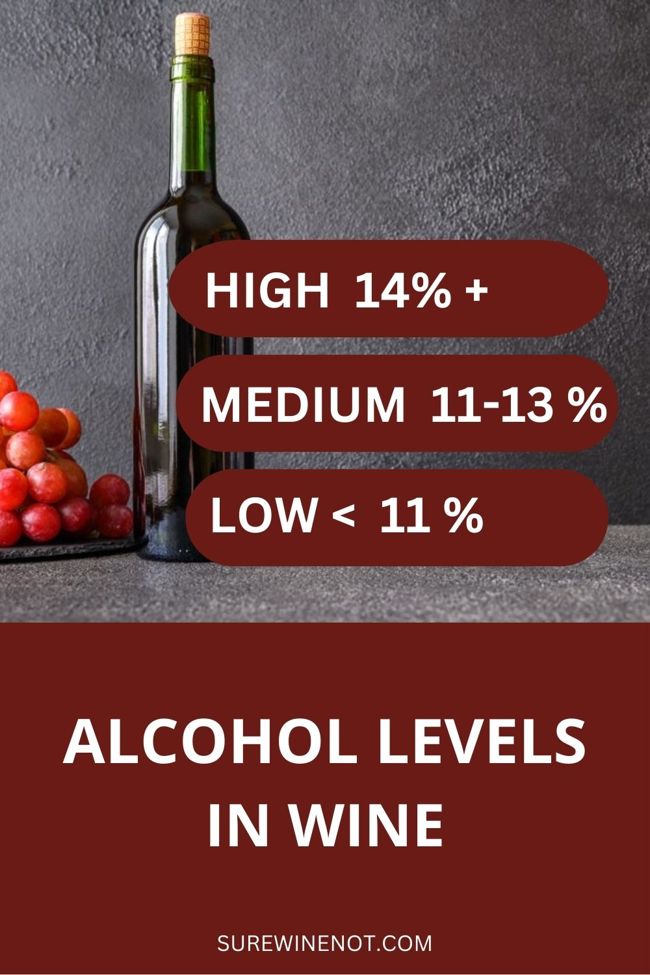
Other sparkling wines
Champagne, Cava and Prosecco are just three of many sparkling wines available around the world.
- Crémant is a French sparkling wine made using the traditional method.
- Sekt is a German or Austrian sparkling wine.
- Asti DOCG is an Italian sparkling wine from Piemonte.
- Australia, California, New Zealand and South Africa are also important producers of sparkling wines.
Sparkling wines and cocktails
Any sparkling wine can be used to make Champagne cocktails; for example, if a recipe requires Champagne to make Kir Royale, you can substitute it for Prosecco or any other sparkling wine.
Similarly, if a Bellini says to use Prosecco and you don’t have it, you can use Crémant or Cava or Champagne instead.
Personally, I prefer to use less expensive sparkling wines for making cocktails and drink the expensive stuff neat, but it really is a personal choice.
Do what is convenient, affordable and preferable to you!
Prosecco glass vs champagne glass
Champagne is traditionally served in a Champagne flute – a tall, narrow glass.
The narrow Champagne flutes help to retain the bubbles and flavor, and look glamorous.
But, if you don’t have flutes, you can serve Champagne in a white wine glass. Some people prefer this option as the wider bowl releases the wine aromas.
Prosecco is often served in a white wine glass, but it can be served in a flute too.
Finally, opening Champagne can be something of an art. So, ensure that you know how to open Champagne and sparkling wines safely and quietly.
